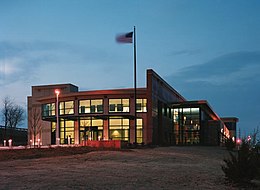
Back بناء مستدام Arabic Yaşıl tikinti Azerbaijani Устойчиво строителство Bulgarian সবুজ নির্মাণ Bengali/Bangla Eko-saverezh Breton Edifici bioclimàtic Catalan Přírodní stavitelství Czech Grünes Gebäude German Βιοκλιματικός σχεδιασμός κτιρίων Greek Bioconstrucción Spanish
It has been suggested that Green building and wood be merged into this article. (Discuss) Proposed since August 2024. |

- LEED 2.0 Gold certified
- Green Power
- Native Landscaping
| Part of a series on |
| Sustainable energy |
|---|
 |
Green building (also known as green construction, sustainable building, or eco-friendly building) refers to both a structure and the application of processes that are environmentally responsible and resource-efficient throughout a building's life-cycle: from planning to design, construction, operation, maintenance, renovation, and demolition.[1] This requires close cooperation of the contractor, the architects, the engineers, and the client at all project stages.[2] The Green Building practice expands and complements the classical building design concerns of economy, utility, durability, and comfort.[1] Green building also refers to saving resources to the maximum extent, including energy saving, land saving, water saving, material saving, etc., during the whole life cycle of the building, protecting the environment and reducing pollution, providing people with healthy, comfortable and efficient use of space, and being in harmony with nature. Buildings that live in harmony; green building technology focuses on low consumption, high efficiency, economy, environmental protection, integration and optimization.’[3]
Leadership in Energy and Environmental Design (LEED) is a set of rating systems for the design, construction, operation, and maintenance of green buildings which was developed by the U.S. Green Building Council. Other certificate systems that confirm the sustainability of buildings are the British BREEAM (Building Research Establishment Environmental Assessment Method) for buildings and large-scale developments or the DGNB System (Deutsche Gesellschaft für Nachhaltiges Bauen e.V.) which benchmarks the sustainability performance of buildings, indoor environments and districts. Currently, the World Green Building Council is conducting research on the effects of green buildings on the health and productivity of their users and is working with the World Bank to promote Green Buildings in Emerging Markets through EDGE (Excellence in Design for Greater Efficiencies) Market Transformation Program and certification.[4] There are also other tools such as NABERS or Green Star in Australia, Global Sustainability Assessment System (GSAS) used in the Middle East and the Green Building Index (GBI) predominantly used in Malaysia.
Building information modeling (BIM) is a process involving the generation and management of digital representations of physical and functional characteristics of places. Building information models (BIMs) are files (often but not always in proprietary formats and containing proprietary data) which can be extracted, exchanged, or networked to support decision-making regarding a building or other built asset. Current BIM software is used by individuals, businesses, and government agencies who plan, design, construct, operate and maintain diverse physical infrastructures, such as water, refuse, electricity, gas, communication utilities, roads, railways, bridges, ports, and tunnels.
Although new technologies are constantly being developed to complement current practices in creating greener structures, the common objective of green buildings is to reduce the overall impact of the built environment on human health and the natural environment by:
- Efficiently using energy, water, and other resources
- Protecting occupant health and improving employee productivity (see healthy building)
- Reducing waste, pollution, and environmental degradation[1]
Natural building is a similar concept, usually on a smaller scale and focusing on the use of locally available natural materials.[5] Other related topics include sustainable design and green architecture. Sustainability may be defined as meeting the needs of present generations without compromising the ability of future generations to meet their needs.[6] Although some green building programs don't address the issue of retrofitting existing homes, others do, especially through public schemes for energy efficient refurbishment. Green construction principles can easily be applied to retrofit work as well as new construction.
A 2009 report by the U.S. General Services Administration found 12 sustainably-designed buildings that cost less to operate and have excellent energy performance. In addition, occupants were overall more satisfied with the building than those in typical commercial buildings. These are eco-friendly buildings.[7]
- ^ a b c "Basic Information". Green Building. US EPA. Archived from the original on 2021-03-28. Retrieved 2021-04-14.
- ^ Yan Ji and Stellios Plainiotis (2006): Design for Sustainability. Beijing: China Architecture and Building Press. ISBN 7-112-08390-7
- ^ Hu M, Skibniewski MJ (April 22, 2021). "A Review of Building Construction Cost Research: Current Status, Gaps and Green Buildings". Green Building & Construction Economics. 2 (1): 1–17. doi:10.37256/gbce.212021. ISSN 2737-5021.
- ^ "EDGE Buildings | Build and Brand Green". www.edgebuildings.com. Archived from the original on 2019-11-20. Retrieved 2019-09-18.
- ^ Hopkins, R. 2002. A Natural Way of Building. Archived 2008-02-03 at the Wayback Machine Transition Culture. Retrieved: 2007-03-30.
- ^ Allen, E, & Iano, J. (2008). Fundamentals of building construction: materials and methods. Hoboken, New Jersey: John Wiley & Sons Inc.
- ^ "GSA Public Buildings Service Assessing Green Building Performance" (PDF). Archived from the original (PDF) on 2013-07-22.